
The silver-ground carpet is a moth of the family Geometridae. The species was first described by Michael Denis and Ignaz Schiffermüller in 1775. It is common throughout the Palearctic region including the Near East and North Africa.It is found in a variety of different habitats and occurs, for example, in humid forests, moorland and shore areas, on embankments or on unimproved grass meadows and heathlands as well as in gardens.
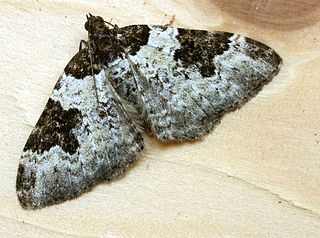
The garden carpet is a moth of the family Geometridae. It is an abundant and familiar species across its huge range which covers the whole Palearctic region from Ireland to Japan and including the Near East and North Africa. It was first described by Carl Linnaeus in his 1758 10th edition of Systema Naturae.
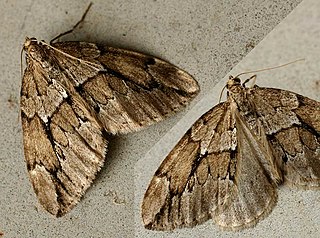
The juniper carpet is a moth of the family Geometridae. The species was first described by Carl Linnaeus in his 1758 10th edition of Systema Naturae. It is found throughout Europe and the Near East, but is rather uncommon and locally distributed, mainly due to its very specific larval food plant.

The garden dart is a moth of the family Noctuidae. It is distributed throughout much of the Palearctic. Temperate regions of Europe, Central Asia and North Asia, as well as the mountains of North Africa. Absent from polar regions, on Iceland and some Mediterranean islands, as well as in Macaronesia.

The common Quaker is a moth of the family Noctuidae first described by Johan Christian Fabricius in 1775. Some authors prefer the synonym Orthosia stabilis(Denis & Schiffermüller, 1775). It is distributed throughout Europe and is also found in Turkey, Israel, Transcaucasia, Russia and eastern Siberia.

The lunar underwing is a moth of the family Noctuidae. The species was first described by Adrian Hardy Haworth in 1809. It has a scattered distribution in western Europe including Spain, Scandinavia and Algeria.

The spruce carpet is a moth in the family Geometridae. The species was first described by Alfred Jefferis Turner in 1925. It is a double-brooded species, meaning it has two broods in one year. Its wings are coloured with different shades of grey, but the spring brood tends to have more brown colours.
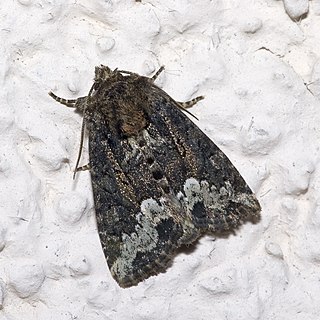
The marbled minor is a moth of the family Noctuidae. The species was first described by Carl Linnaeus in his 1758 10th edition of Systema Naturae. It is distributed throughout Europe, east through the Palearctic to central Asia and the Altai Mountains. It rises to heights of over 1500 meters in the Alps.
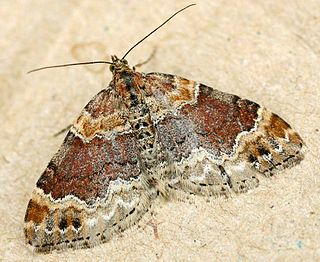
Xanthorhoe spadicearia, the red twin-spot carpet, is a moth of the genus Xanthorhoe in the family Geometridae. The species was first described by Michael Denis and Ignaz Schiffermüller in 1775.

Chloroclysta siterata, the red-green carpet, is a moth in the family Geometridae. The species was first described by Johann Siegfried Hufnagel in 1767.

Hylaea fasciaria, the barred red, is a species of moth in the family Geometridae. The species can be found in central and northern Europe, the Urals, Caucasus, Altai and eastern Siberia.

Theria primaria, the early moth, is a moth of the family Geometridae. It is found throughout Western Europe and the South Caucasus.

Thera variata, the spruce carpet, is a moth of the family Geometridae. It is found throughout Europe, North Asia and Japan. The common name spruce carpet is also used when referring to Thera britannica.

Pelurga comitata, the dark spinach, is a moth of the family Geometridae. It is found throughout the Palearctic, including Europe, Siberia, the Russian Far East and northern China

Scotopteryx chenopodiata, the shaded broad-bar, is a moth of the family Geometridae. It was first described by Carl Linnaeus in his 1758 10th edition of Systema Naturae.

Orthosia incerta, the clouded drab, is a species of moth of the family Noctuidae, found in Europe and Asia. The occurrence of the species extends through all European countries through the Palearctic to the Russian Far East and Japan. It is absent from northern Fennoscandia and in the Alps it occurs up to 2000 m above sea level.

Thera obeliscata, the grey pine carpet, is a moth of the family Geometridae. It is found throughout north and central Europe and east across the Palearctic to Siberia, and south to the Caucasus and Transcaucasia. In the Alps it can be found at an altitude of over 1500 metres.
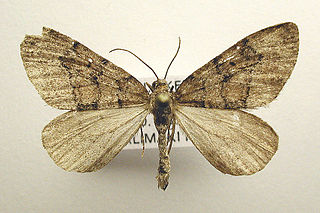
Thera cognata, the chestnut-coloured carpet or Durham juniper moth, is a moth of the family Geometridae. The species was first described by Carl Peter Thunberg in 1792. It is found in Europe, Asia Minor, the Caucasus and Transcaucasus.

Chloroclysta miata, the autumn green carpet, is a moth of the family Geometridae. The species was first described by Carl Linnaeus in his 1758 10th edition of Systema Naturae. It is found from most of Europe to the Alatau in Central Asia.

Epirrhoe galiata, the galium carpet, is a moth of the family Geometridae.





















